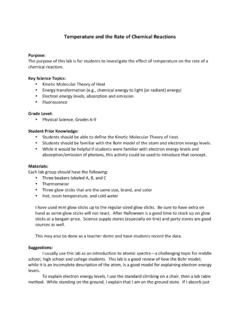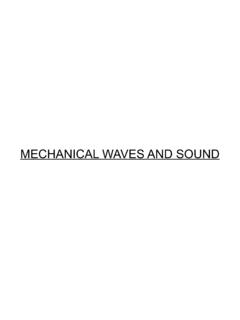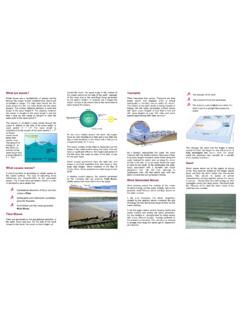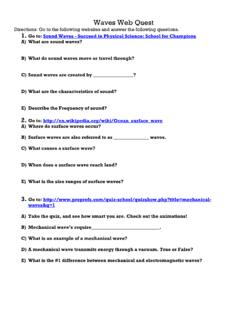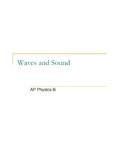Transcription of The Electromagnetic Spectrum—Answer Key - uwyo.edu
1 The Electromagnetic spectrum Answer Key Radio waves Longest wavelength lowest frequency Wavelength range: 106m to 1m Usually described by their frequency Different types of radio waves (from high f to low f are: RADAR, CB (Citizen s Band), FM, Television, AM, Shortwave, Satellite, Communications AM stands for amplitude modulation and is given in kHz FM stands for frequency modulation and is given in MHz 1st Radio waves were transmitted/detected by Heinrich Hertz The first wireless radio device was invented by: Guglielmo Marconi Can be reflected or transmitted by Earth s atmosphere Cosmic Connection: SETI: Search for Extra Terrestrial Intelligence Closely related to x-ray or gamma-ray events Guglielmo Marconi (1874-1937) Microwaves Name means: small radio waves Wavelength range: 1m to 1 cm Non-ionizing; when absorbed they cause water molecules to vibrate, creating heat. First developed during WWII and used for communications.)
2 Causes: cataracts Calculating the Speed of Light = _____ x _____ c = _____ % error = Cosmic Connection: Penzias and Wilson detected the Cosmic Microwave Background Radiation (CMBR). Left over radiation from the Big Bang Uniform to 1 part in 1 billion (Nobel Prize in 1978) Telescope used by Penzias and Wilson at Bell Labs Infrared Rays Name means: Below red heat rays Wavelength range: Near: 1-5 m Mid: 5-40 m Far: 40-350 m Uses: TV remotes, photography, thermal imaging Discovered in 1800 by William Herschel using a prism and a thermometer. Non-ionizing; when absorbed they cause atoms to vibrate Cosmic Connection: Great indicator of star forming regions Google Image Search Visible Light Small band of frequencies that the retina of the eye responds to. Wavelength range: : 400-700 nm --Color receptors: cones --Black/white receptors: rods Longest wave, lowest frequency: red Shortest wave, highest frequency: blue First separated into the visible spectrum by: Isaac Newton Cosmic Connection: -Identifying atomic spectra -Lightcurves of extrasolar planets Ultraviolet Rays Wavelength range : 400nm to 10 nm Discovered in 1801 by Johann Ritter Tried to find cold-rays past the violet end of the spectrum after hearing about Herschel s heat rays.
3 White Silver Chloride turned dark when exposed to light past the violet end of the spectrum Named the new wavelength Ritter Rays, were later named ultraviolet 3 Kinds: UVA: 400-315 nm UVB: 315-280 nm UVC: 280-100 nm UVB and C destroy DNA at the cellular level UVB produces vitamin D in skin up to 1000 IUs per min. Regulates bone growth, immunity, and blood pressure. Uses: Forensics, UV curing of finishes, fluorescence, optical brighteners, black lights X-Rays Wavelength range: to 10 nm Discovered in 1895 by Wilhelm Roentgen Man-made x-rays are made by a vacuum tube that generates high voltages to accelerate electrons (cathode). The high velocity electrons collide with a metal target usually tungsten (anode) . Uses: Hard: inspection of bridges, beams, building construction Soft: x-ray crystallography, medical diagnosis and treatment Gamma Rays Wavelength: 10 pm Discovered in 1900 by Paul Villard Produced by : nuclear fission, fusion, and decay Gamma-ray astronomy: Started in late 1960/early 1970 with the Vela satellite.
4 Was used to detect suspected nuclear bombs detonated from space during the Cold War but instead found large amounts of energy from cosmic sources Ground-based gamma-ray detection: Cherenkov radiation occurs when high-energy particles hit the earth s atmosphere. A shower of gamma rays is produced. Cosmic Rays *Not technically light, but particles travel close to c. Discovered in 1912 by Victor Hess Energetic particles originating from space May be from: Supernova, solar flares, gamma-ray bursters, and other high-energy events.
